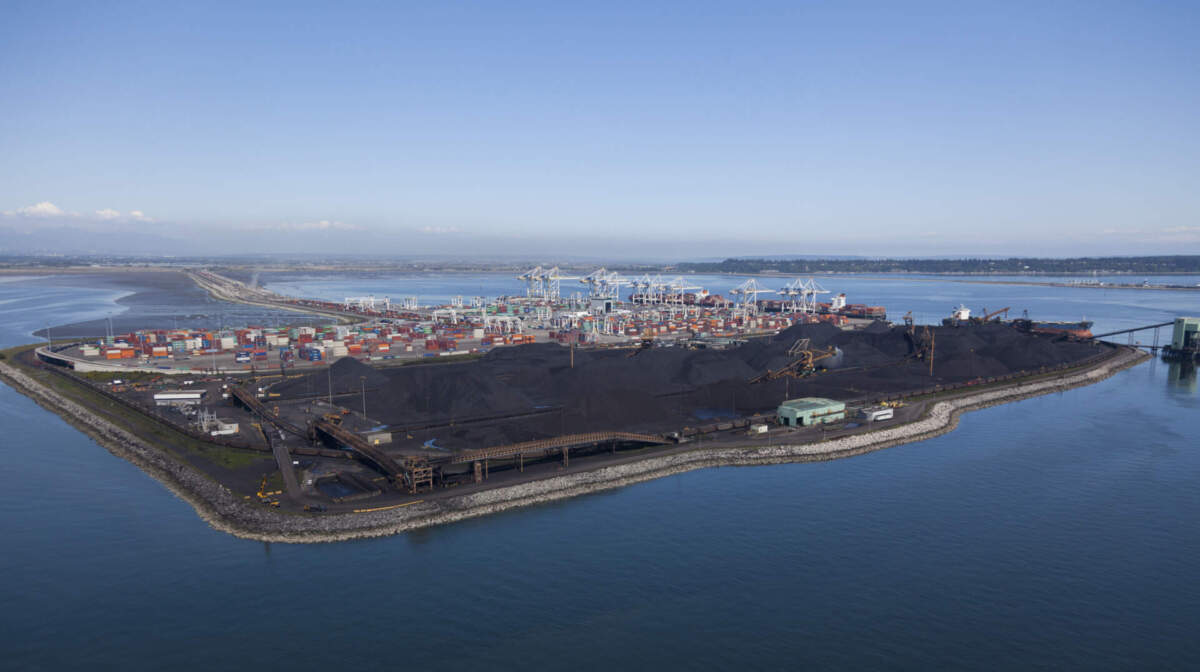
Vancouver, Canada – May 13, 2010: Deltaport is Metro Vancouver’s largest coal and container port, located at Roberts Bank. The terminal is designed to handle the largest container ships in the world, and features dual-hoist gantry cranes, the first of their kind in North America.
For the month of October, Canada posted its largest surplus of 2021 . This surplus, totalling $2.1B with the world and $8.3B with the United States, is just shy of that forecasted and is owing partly to an overdue rebound in the trade of passenger cars and light trucks.¹ This surplus is substantially larger than that recorded in September, totalling just $1.4B.2
In the details, imports rose by 5.3% to $54.1B.¹ Exports were up even higher in October, climbing 6.4% to $56.2B.¹ The increase in both of these categories is driven by trade activity with the United States.
October’s numbers may include the beginnings of consumer Christmas shopping. But given Canada’s recent spate of natural disasters, consumers should be rightfully worried how the fragile supply chain may impact their Christmas plans. Statcan noted in this month’s release that the devastating flood events in British Columbia is expected to impact international merchandise trade data for the month of November. That data will be released January 6, 2021.¹
This trade balance update reflects on Statcan data pertaining to October 2021; reports are generally released 35 days following month end.
Survey by Sector
The category including motor vehicles and parts contributed the most to Canada’s growing trade surplus in October, driving almost two-thirds of the increase. This is in contrast to September, which saw a total 3.1% decrease in imports also largely owing to a slowdown in motor vehicle trade.¹
After the category decreased by a total 13.8% in September, imports of motor vehicles and parts rose 27.2% in October, hitting a total of $8.5 billion. This showing is a level similar to those recorded by Statcan before supply chain volatility began last year. These supply chain issues and corresponding trade volatility in the motor vehicle categories are caused by the ongoing semiconductor chip shortage, which continues to impact the trade of consumer goods internationally.¹
That said, imports of consumer goods did increase in October by a total of 4.5%. This is the third consecutive monthly increase, and could reflect an uptick in holiday shopping as many Canadians prepare for the first “real” Christmas since the pandemic began. Imports of clothing, footwear and accessories (+15.4%) increased the most in October, mostly on higher imports from Asian countries. This trend is notable in light of Trudeau’s push to reopen trade discussions with the Association of Southeast Asian Nations (ASEAN) and diversify Canada’s trade relationship with China, discussed below.¹
The category including COVID-19 vaccines also increased imports in October by 6.6%. It’s anticipated there will be an observable increase in imports of influenza vaccines as—despite the spread of the Omicron variant—economies and communities remain mostly “open”. This follows from 2020’s remarkable lack of need for influenza vaccines, as people were largely observing social distancing restriction during the second wave of the COVID-19 pandemic.¹
BC’s Natural Disaster Challenges Trade
News cycles all over the world ran coverage on British Columbia’s recent flooding. The devastating rains and corresponding floods caused the deaths of at least 4 people, 500 cattle, and 100,000 chickens. Roads have washed away, crippling trade in the lower mainland for days.³
“This storm proved how fragile the supply chain really is,” says William McKinnon, President of Canadian Alliance Terminals. “We’ve seen these upsets occur elsewhere throughout the year but these rains proved that disasters like this can—and will—happen in our own backyard.”⁴
Following the washout of the Coquihalla Highway—the main artery between the BC Interior and the Greater Vancouver Regional District—government officials announced it will be two months before even minimal commercial traffic will resume. Extensive repairs will be costly and possibly delayed by further bad weather.⁵
“There’s much discussion about ‘building back better’,” says McKinnon. “But at base, these repairs will take months; then, making significant structural changes will only drive up costs and draw out the repair schedule. Where will the money come from?”⁴
As supply chain managers across Canada struggle to reroute product, the question of localizing DC strategies in remote areas makes more and more sense.
“We are in the perfect position,” says McKinnon. “We’re located close to Deltaport, the airport, have access to rail, and—in time—will have highway access once again. This event has demonstrated the importance of keeping your options open. Without options, your speed to market could be decimated.”⁴
Limited Relief in Sea Can Cost
The Loadstar reported this month that sea can spot prices fell in recent weeks, in keeping with typical annual trade rhythms. While this decrease will certainly benefit some lucky customers, the bulk of high volume, long term contracts will not see a corresponding decrease in price.⁶
“We shouldn’t expect that these falling spot prices are harbingers of more affordable sea freight,” says McKinnon. “For those of us trying to secure high volume contracts, there has been little to no change.”⁴
It’s been nearly a year since the cost of sea freight first began climbing—and climbing, and climbing—and it’s assumed that shipping companies are willingly capitalizing on global trade upset.⁸
“I am sure we’ll still see some fluctuation in the future,” says McKinnon. “But yes. I would say this is the new normal for our industry.”⁴
The Human Cost of Trade
In an attempt to diversify Canada’s trade relationship with Asia, Trudeau has reopened discussion with the 10 countries of the Association of Southeast Asian Nations. These nations—Indonesia, Singapore, Malaysia, the Philippines, Brunei, Cambodia, Lao People’s Democratic Republic, Myanmar, Thailand and Vietnam—represent a market of over 600 million people.⁹
These talks began in 2018 as mere “dialogue.” Now, they’ve restarted in earnest—but the Trudeau government faces a challenging road ahead. While a preferred trade relationship may strengthen Canada’s independence, many ASEAN countries have a history of pervasive human rights violations.⁹
That’s not to say China, for example, has a sparkling record. But does the Trudeau government really want to pursue relationships with the likes of Rodrigo Duterte, famous for his murderous “war on drugs”?
“Partnering with these countries could meaningfully cement Canada’s prioritization of trade and consumerism over human rights,” says McKinnon. “It would not align with Canada’s moral compass. But this is a compromise many countries have already made, including Canada; it is, in part, the West’s thirst for consumer goods that drive many of the human rights violations in question.”¹⁰, ⁴
The possibility of this partnership could signal growing desperation to extricate Canada’s economic outlook from China. And it could, theoretically, help fortify Canada against the supply chain issues gripping its provinces today. But at what cost?
